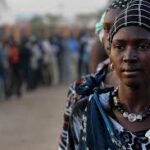After more than 16 months of intense conflict in Sudan, famine conditions have emerged in Zamzam internally displaced persons (IDP) camp in North Darfur State, marking the first report of famine globally since 2017. On August 1, 2024, the Integrated Food Security Phase Classification (IPC) Famine Review Committee (FRC) revealed that ongoing hostilities have driven communities in Zamzam, near Al Fasher, into famine (IPC 5) conditions as of June and July 2024. These dire conditions are likely to persist into August through October 2024.
The IPC FRC also highlighted the risk of famine spreading to 13 other regions within North Darfur State and neighboring areas, emphasizing the need for immediate assessments of IDP camps such as Abu Shouk and Al Salam. With the country facing unprecedented food insecurity, more than half of Sudan’s population—25.6 million people—are in acute hunger, including over 8.5 million at emergency levels (IPC 4). Most alarmingly, over 755,000 people, particularly in Darfur and Kordofan, are already experiencing famine-like conditions. Clementine Nkweta-Salami, the Humanitarian Coordinator in Sudan, emphasized the dire need for international intervention: “We need the guns to be silenced to enable humanitarians to reach the people in need. We need an urgent injection of funding for the aid operation as well as safe and unimpeded humanitarian access, including across borders and battle lines.” Without an immediate ceasefire, humanitarians cannot operate effectively. Funding, access, and political coordination are critical for scaling up the response to alleviate famine conditions. This requires unfettered humanitarian access across conflict zones and border areas, a call echoed by relief agencies on the ground.
Adding to the growing crisis, heavy rains since June have triggered massive flooding in 13 out of Sudan’s 18 states, displacing over 124,600 people and affecting more than 442,600 residents across the country. The floods have particularly impacted Zamzam and Abu Shouk camps, destroying infrastructure and further complicating the humanitarian situation. In Zamzam alone, nearly 900 tents were washed away, leaving vulnerable families homeless. Flooding has caused significant delays in humanitarian aid deliveries, particularly in Darfur, Kordofan, and Khartoum, where road access is severely hindered by both conflict and weather conditions. Northern and River Nile states have reported increased risks of scorpion and snake infestations, while standing water exacerbates the threat of disease outbreaks. While the rains have bolstered crop farming, they have also devastated essential infrastructure, hampering both food production and relief efforts.
As if the famine and floods were not enough, Sudan is also grappling with a cholera outbreak. Officially declared by the Federal Ministry of Health (FMoH) on August 12, 2024, this outbreak has claimed 112 lives with over 2,800 cases reported in Kassala, Gedaref, and River Nile states, among others. A cholera vaccination campaign, supported by the World Health Organization (WHO) and UNICEF, has reached more than 51,000 people, with further vaccines on the way to cover vulnerable populations.
This effort, though successful, is only a small part of a larger battle against the cholera epidemic spreading across the country. WHO is coordinating with the International Coordinating Group (ICG) to deploy more vaccines and set up cholera treatment units (CTUs) and Oral Rehydration Points (ORPs) to treat affected individuals. Yet, widespread flooding and a lack of infrastructure continue to hinder the full-scale deployment of these critical medical resources.
The conflict in Sudan has displaced millions of people, both internally and across neighboring borders. As of mid-August 2024, more than 73,000 people were displaced within Sudan, while over 3,600 fled to surrounding countries. This brings the total number of displaced people since April 2023 to 10.3 million, marking Sudan as the largest displacement crisis in the world. The capital, Khartoum, has seen the highest displacement figures, followed by South and North Darfur.
Compounding the crisis, aid workers themselves have become displaced. Many Sudanese humanitarian workers have fled to Chad, Egypt, Kenya, and other neighboring regions, further weakening the country’s response capacity. This internal displacement crisis is hindering the deployment of essential resources, worsening the plight of those trapped in conflict zones. Despite access restrictions and severe funding shortfalls, humanitarian organizations have been implementing the Famine Prevention Plan (FPP), launched in April 2024. This ambitious plan targets 7.6 million people in acute need, prioritizing regions at risk of famine. By July 2024, at least 5.6 million people had received some form of humanitarian aid, including food, safe water, sanitation, and medical care.
Efforts to coordinate this multi-cluster response have been bolstered by the creation of the Sudan Operations Coordination Center (SOCC) in Port Sudan, with further hubs planned in conflict-affected areas. However, the ongoing violence continues to obstruct aid efforts, making the delivery of life-saving assistance increasingly difficult. In a critical development, the reopening of the Adre border crossing between Chad and Sudan’s Darfur region has provided a much-needed humanitarian corridor. Since its reopening on August 16, 59 aid trucks have crossed into Darfur, carrying essential supplies for nearly 195,000 people. This route, closed since February 2024, is vital for delivering food, medicine, and shelter to conflict-affected populations.
UN Deputy Secretary-General Amina Mohammed visited Port Sudan in late August to assess the humanitarian situation and emphasize the importance of sustained aid deliveries through the Adre crossing. Her visit marked a crucial moment in the international community’s efforts to address Sudan’s multifaceted crisis.
Even with these successes, humanitarian operations are still being delayed. In mid-August, the World Food Programme (WFP) reported that over 50 trucks carrying food and nutrition supplies had been stranded across Sudan due to flooding and poor road conditions. These supplies, enough to feed half a million people for three months, are urgently needed, but the obstacles posed by both natural and man-made factors are proving formidable.
As famine conditions worsen and the humanitarian crisis deepens, Sudan stands on the brink of a catastrophe unseen in recent years. A coordinated global response, anchored in immediate funding, unrestricted access, and peace negotiations, is essential to avert further loss of life. The international community must rally to ensure that Sudan’s vulnerable populations receive the urgent relief they desperately need. With famine, floods, cholera, and displacement tearing the nation apart, only a robust and unified intervention can restore hope to millions.







Leave a Reply